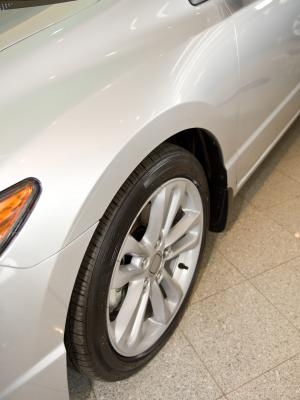
Correct vehicle alignment requires review of three different factors. Toe is the measurement of the leading edges of the wheels, whether pointed inward or outward. Camber is the measurement of the wheels as seen from the front of the vehicle. If the wheels lean in at the top toward the engine, the vehicle has negative camber. Caster is the direction of pivot as viewed from the side of the vehicle. If the pivot of the vehicle is leaning forward or rearward, the caster is out. The caster is best and more easily determined by a laser guided alignment machine.
Inflate the tires on your vehicle to the suggested tire pressure. The recommended tire pressure is on a placard on the driver's doorframe of most vehicles. If your vehicle does not have this placard, do not exceed 35 pounds per square inch on any passenger vehicle. Straighten the steering wheel of the vehicle.
Standing in front of the vehicle, visualize a straight line off the side of the vehicle, through the wheels. Make the same visual inspection on the other side of the vehicle. If the wheel on one side of the car turns inward or out more than the other side, then your toe is out of adjustment. Bad toe adjustment will make your tire edges wear out more on one side than another side. If the wheels turn dramatically -- 1 inch or more in or out -- then the car needs an alignment.
Visually inspect the wheels on a vertical scope. If the top of the tire leans inward or outward severely, then its camber is out of adjustment. Poor camber adjustment can cause tires to wear more on one edge than the other edge.
Drive the vehicle onto a road that is smooth, and does not drop off sharply at the curb. The middle lane of a highway or three-lane road is usually the best place to perform the road test.
Increase your speed to 35 mph if you are on a residential or suburban three-lane road. Do this only if it does not exceed the speed limit and traffic is minimal. Increase your speed to 55 or 60 mph if you are on a highway, if it does not exceed the speed limit and traffic is minimal.
Let go of the steering wheel for no longer than three-second intervals. Repeat this motion about two to three times. If the vehicle travels slightly or sharply to one side, then have the alignment inspected by a professional.